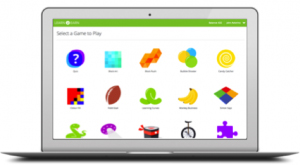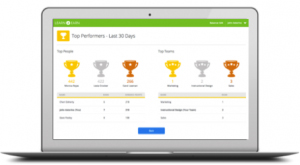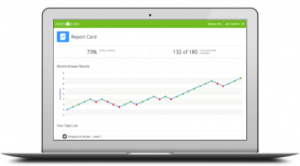Gamification applied to learning is receiving a lot of attention these days, and corporate learning teams are being tasked with identifying how best to incorporate it into their learning strategies.
At its simplest, gamification is the process of making non-game activities more fun and engaging. Karl Kapp, a respected expert on the convergence of learning and technology, defines gamification as “a careful and considered application of game thinking to solving problems and encouraging learning, using all the elements of games that are appropriate.”
While there’s a great deal of information available on how to add gaming elements to learning, there hasn’t been much intelligence published about how people react, act, or perform within gamified learning environments, until now.
At Axonify, we believe we’ve accumulated the largest body of data related to which game mechanics actually work in the real world of corporate learning. Every day, hundreds of thousands of employees from world-class organizations like Walmart, Toys R Us, and J&J interact with our gamification elements, resulting in more than 50 million discrete interactions per year! From these interactions, we are able to extract important information about gamification and its impact on learning.
What we’ve discovered is pretty amazing.
Lesson one: Game popularity is a formula
The Axonify platform embeds learning in short games that range from arcade-style play to word puzzles to brain games. In developing, testing, and releasing hundreds of games to learners, we’ve concluded that it’s not the style of game that makes a game popular, but rather the presence of three key components (Figure 1).
- Multi-level action: Learners must be able to progress through levels of difficulty, which gives them a continuing sense of achievement.
- Challenging: Games must continually challenge the learners, encouraging them to stretch beyond their comfort zones. Sometimes this will result in success, and sometimes it will result in failure. But with their comfort level from recreational gaming, most of today’s learners take failure in stride and, within a game environment, find it motivational.
- Fun: learning games must be fun, which helps keep learners excited, motivated, and engaged in the learning process.

Figure 1: Game popularity =
multi-level + challenge + fun
When you combine multi-level action with challenges and fun, participation goes through the roof. Pep Boys has been using Axonify for several years to help reduce retail shrink by a whopping 55 percent, a result almost unheard of in retail. Bryan Hoppe, VP Operations, says, “The most surprising benefit of Axonify was how well it was received and continues to be received by our employees. We get well over 95 percent participation in our Axonify learning, and the game approach is a big part of why employees are sticking with it.”
Lesson two: Game-play variety is critical
Offering a large selection of games and game types is essential to driving participation in learning.
A key reason is that learners become partial to specific types of games and will participate more enthusiastically if the games meet their preference. For instance, a Millennial retail associate may prefer “Angry Birds”-style games, while a Baby Boomer may be more drawn to “Color Fill,” a game that combines luck and skill.
One of the things we’ve found is that of the total number of learning games played on our platform, there’s no clear winner in terms of user preference. Learners are creating their own variety by choosing different games to keep the experience fresh and interesting. This helps avoid the disconnect that could occur if learners master a particular game or get bored.
Lesson three: Leaderboards drive competition and community
It’s important to have both personal and team leaderboards. In fact, nearly 100 percent of Axonify users check their leaderboard weekly, and 37 percent check every single day! Clearly they care about how they and their teams stack up against the competition (Figure 2). Team leaderboards drive social connectedness, creating a strong sense of community.

Figure 2: Team leaderboards drive
competitiveness and social connectedness, creating a strong sense of community
Capital Blue Cross is a US health-insurance company with over 2,000 employees in Pennsylvania. They were looking for a solution that would allow them to centralize training, reinforce classroom-based instruction for improved effectiveness, plus easily and swiftly communicate procedure changes.
What surprised them was how engaged their employees would become in their own learning. According to Mike Keeler, their VP of operations, “It’s the ongoing friendly competition that has our people looking forward to their daily training session: that, and the fact that they can immediately see how they are stacking up against their colleagues. Our employees check their leaderboards 64 percent of the time that they log on for their training sessions. I’m sure that’s a major contributor to the results we’re seeing, which include knowledge lifts of up to about 85 percent on most of our critical topics. That’s huge for our business, where we have complicated procedures, and growing complexity driven by healthcare reform.”
Lesson four: Tangible rewards are a key to participation
While intangible rewards such as recognition, interesting challenges, and badges motivate many people to learn, we’ve found that by adding tangible rewards employers can dramatically drive participation and enhance the overall learning experience. These rewards vary from company to company, but can include everything from gift cards to company swag to vacation days.
Clients that take advantage of the Axonify-reward auction feature with tangible prizes achieve at least 15 percent more participation than those who don’t.
We’ve seen the most dramatic impact of adding rewards with the Kaplan Higher Education Group, who utilize the Axonify platform to reinforce learning with their student support and internal training teams.
J.D. Dillon of the Kaplan Higher Education Group describes the impact of rewards in their environment. “In our Axonify implementation, we’re experiencing over 90 percent voluntary participation for those pockets of learners with achievable, tangible rewards. That contrasts to 40 percent voluntary participation when learners do not yet have tangible rewards in place.”
Lesson five: Learners appreciate having a coach
In our learning environment, learners have the option of choosing a coach. These virtual coaches motivate learners by celebrating when they do well, and looking disappointed when they don’t.
At first glance, it wouldn’t seem very critical to the learning process, but we were surprised to find that of the hundreds of thousands of people using Axonify, over 80 percent of them take the time to select a Coach that appeals to them. It was also interesting that people preferred the term Coach over the term Avatar. In the video-gaming world, an Avatar is a virtual representation of the person playing the game. This suggests to us that people feel more comfortable with someone at their side offering support, rather than looking at a virtual representation of themselves.
We’ve also found that it’s important to offer the ability for learners to select from a variety of Coaches, so they can choose one that they feel most comfortable with. Some select very realistic looking coaches, while others prefer a fun, “cartoony” character.
Lesson six: Employees like to see their progress
While tangible rewards motivate many learners, there are also intrinsic motivators that drive many people to succeed, such as the feeling of achievement or desire for self-improvement.
These learners want to see their own progress so they can analyze their performance and make the adjustments necessary to improve (Figure 3). It’s extremely important to provide a progress report that:
- Is easy to access and understand
- Provides a graphical interface
- Allows for drilling down to deeper detail

Figure 3: Access and illustrate an
individual’s progress in a simple, digestible format
We have found that 9 percent of Axonify users check their report card daily, and 7 percent take extra training so they can improve their scores. This can be quite significant when you consider that these employees likely represent your population of self-directed learners, often on the promotion track.
Lesson seven: Social connectivity creates learning engagement
One of the most powerful engagement tools in next-generation online-learning environments relates to social connectivity—connecting employees to each other, to learning content, and to the organization. Providing a forum for employees to engage socially and contribute content is not only beneficial, but in the age of Facebook and Twitter, it’s expected.
We’ve found that the ability for learners to contribute content is quickly becoming one of the most popular features of our system: over 15 percent of Axonify users engage socially every day, and that number continues to grow.
This is exciting news; it’s an area where organizations can dramatically improve employee engagement. We believe there are significant benefits to adding social connectivity to the learning experience:
- Social connectivity relies on active participation, increasing engagement in the overall learning experience.
- Employees are able to contribute as collaborators and team players, increasing their connectedness to coworkers.
- Employees feel they are contributing to the learning experience of their coworkers.
- As contributors to the knowledge base, employees feel more connected to the success of their organization.
Get A+ on your learning report card
These powerful—and surprising—lessons prove that gamification more completely engages learners. But you also need to pay attention to detail. Provide variety, challenge, and community. Offer rewards. Allow employees to contribute to your knowledge base.
By adding gamification to your learning, then refining it to meet learner preferences, you will more fully engage your employees to deliver the results you need: better knowledge retention, improved job performance, and a workforce aligned with your vision.



